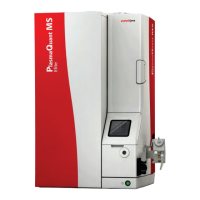PlasmaQuant MS product family Method development
71
3. Select the A
NALYSIS TYPE:
Q
UANTITATIVE: Typically used for routine quantitative elemental analysis
S
EMI-QUANTITATIVE
S
TANDARD ADDITIONS
4. Type the number of standards included in the analysis in the N
UMBER OF STANDARDS
field.
5. To change the names of the standards:
Click the [E
DIT STANDARD LABELS] button. A pop-up window appears, and the
individual names of each calibration standard can be edited here.
Specify a new name for each standard.
It can be useful to give the standards a descriptive name, indicating which
elements are in it, or when it was made.
Click [OK] to save changes.
6. For each standard in the S
TANDARD CONCENTRATIONS table:
Select a unit of concentration from the drop-down list.
Type a concentration value for the standard.
It is possible to measure elements with different concentration units and values
in the same worksheet.
7. Configure calibration parameters. The availability of calibration parameters is
dependent on the analysis type:
For a semi-quantitative analysis, no calibration parameters are available.
For a standard additions analysis, only
WEIGHTED FIT and CORRELATION COEFFICIENT
LIMIT
are available for each isotope.
For a quantitative analysis,
THRU BLANK, WEIGHTED FIT, MAX % ERROR, RESLOPE
STANDARDS
, MAX % RESLOPE CHANGE, and CORRELATION COEFFICIENT LIMIT are
available. For a detailed description of these options, see the software help.
During method development, to ensure that a calibration curve is generated under
most conditions, it is recommended to set the Max % error value quite high (e.g.,
50 %) or simply exclude the Max % error check (leave this check-box blank), then
study the calibration curve to determine the optimal calibration parameter settings.
Some common causes of calibration failure include poor preparation of the standards,
incorrect entry of concentration values, blank contamination, and poor standard/s
precision.
7.6 Enter scan settings
The scan settings page is used to configure the quadrupole scan mode and parameters.
These include dwell time, scans per replicate, replicate per sample, and detector
attenuation factors, most of which can be left to their default settings for typical
applications. Refer to section 9 for detailed information on detector attenuation
factors.
1. From the main page of the worksheet, click [E
DIT METHOD].
2. Select the S
CAN SETTINGS tab.

